Wetlands
What is a wetland?
- Defined as: those areas that are inundated or saturated by surface or groundwater at a frequency and duration sufficient to support, and that under normal circumstances do support, a prevalence of vegetation typically adapted for life in saturated soil conditions. Wetlands generally include swamps, marshes, bogs, and similar areas.
Why worry about wetlands?
- Approximately 80 percent of the Chagrin River watershed's historic wetlands have been drained, filled, and converted to urban or agricultural uses.
- Wetlands provide critical functions to our area’s ecosystem such as water filtration, sediment removal, flood and erosion control, groundwater recharge, and some of the most diverse plant and wildlife habitat.
- Wetlands can be found on many properties.
- Wetlands are strictly regulated by state and federal authorities. In Ohio, ALL wetlands and other waters are regulated by either The United States Army Corps of Engineers or Ohio Environmental Protection Agency. Nearly all impacts to wetlands and other waters require compensatory mitigation to offset losses.
Wetland issues:
- Wetland soils
- have poor physical properties and are often not suitable for building and septic
- have increased problems with flooding and poor drainage
- Wetland permits
- can be expensive and time-consuming
- Public concern
I have a wetland on my property. What is required of me?
- Keep it undisturbed. Do not mow the wetland or clear it of vegetation.
- Maintain a buffer of native vegetation between the wetland and structures, pavement or manicured lanscaping.
- Prevent pollution from reaching wetlands.
- Remove trash or invasive species from wetlands.
- Check to see if your community has a wetland setback ordinance.
More resources:
- USFWS National Wetlands Inventory/Wetlands Mapper (please note, the mapper does not include all wetlands; site-specific conditions such as soil type, hydrology, and vegetation type will confirm the presence of wetlands)




